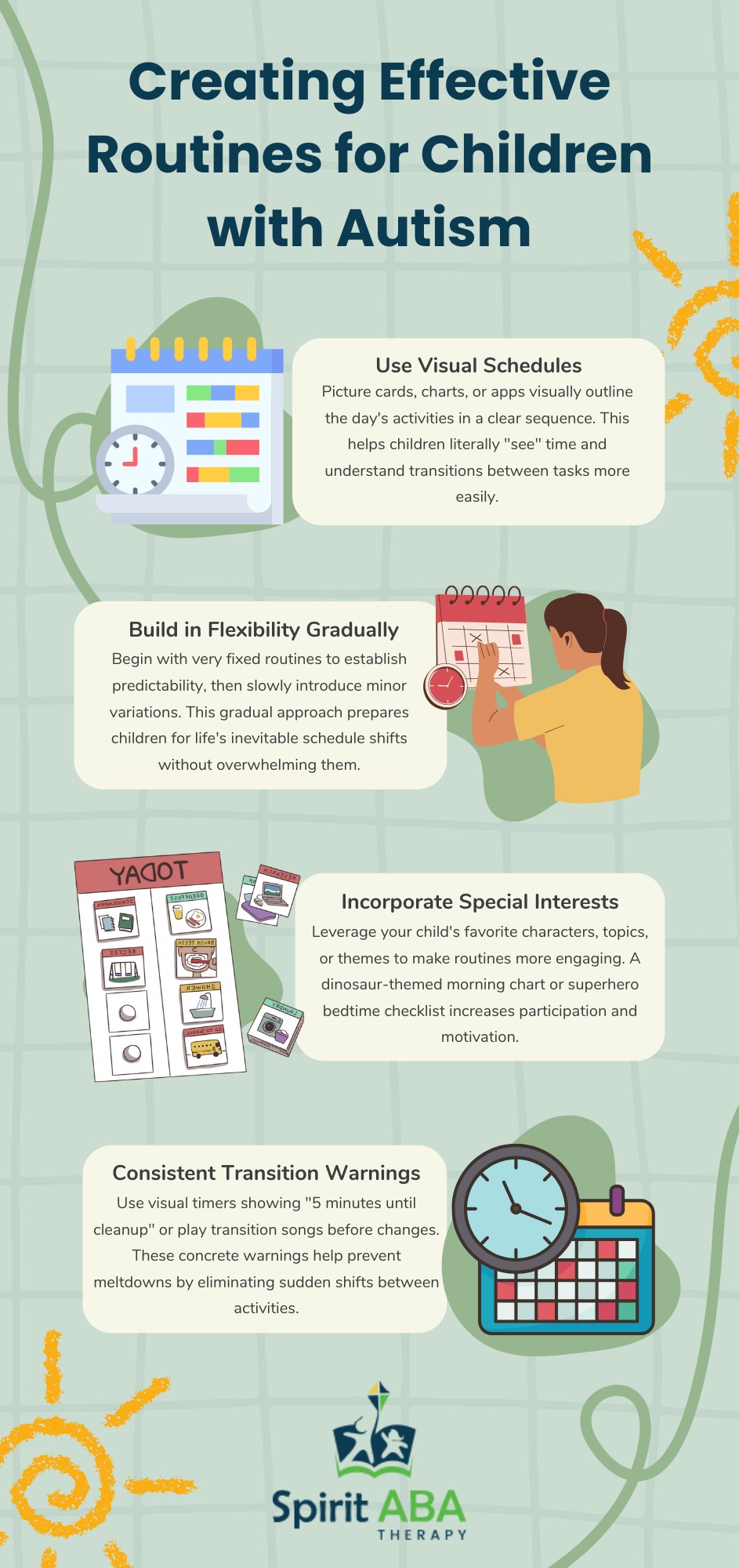Key Points:
- Consistent routines provide stability, reduce anxiety, and improve daily functioning for children with autism.
- Predictable schedules help develop independence, communication, and emotional regulation skills.
- Visual supports and structured transitions make routines more effective and manageable for families.
For children with autism, routines are like comfort blankets made of time. When we understand why “Is routine good for autism?” is such an important question, we unlock powerful ways to help our children feel safe, focused, and ready to learn each day.
Is Routine Good for Autism?
Yes, routine is exceptionally beneficial for autism. Children on the spectrum often thrive on predictability—it reduces anxiety, minimizes meltdowns, and helps them understand expectations. A structured daily schedule answers the question “Is routine good for autism?” with clear evidence: it promotes security, learning, and positive behaviors.
For parents, establishing routines might feel challenging at first, but the long-term benefits are undeniable. When children know what to expect, they feel more in control of their environment. This is especially important for those with autism, who may struggle with unexpected changes or sensory overload.
Why Do Children with Autism Need Routine?
Children with autism often experience the world as unpredictable and overwhelming. A consistent routine acts like an anchor—it provides stability in what might otherwise feel like chaos. This isn’t just about keeping a schedule; it’s about creating a safe, understandable framework for daily life.
Without structure, everyday activities like getting dressed or leaving the house can become stressful. But with a clear routine, these tasks turn into manageable steps that children can learn and master.
How Routines Support Development in Autism
Routines do more than just prevent meltdowns—they actively encourage growth in key areas:
1. Communication Skills
When activities follow a predictable pattern, children begin to anticipate what comes next. This helps them associate words with actions (e.g., “time to eat” before meals), building both vocabulary and understanding.
2. Emotional Regulation
Knowing what to expect reduces frustration. A child who struggles with transitions might resist bedtime less if a visual schedule shows “brush teeth → story → lights out” every night.
3. Social Interaction
Structured playtimes or group activities within a routine provide safe opportunities to practice turn-taking and other social skills.
Creating Effective Routines for Children with Autism
Wondering how to implement routines that actually work? These evidence-based approaches make the structure manageable for both kids and parents while reducing stress and building independence.

Each strategy works best when implemented consistently and tailored to your child’s unique needs and developmental level. Start with one method and expand as your child adapts.
Handling Routine Changes
Even the most carefully planned schedules will face disruptions, and that’s completely normal. For children with autism, unexpected changes can feel overwhelming, but there are effective ways to ease these transitions while minimizing distress. The key is preparation and gradual adaptation.
For small changes, advance notice makes a big difference. Clearly state adjustments like, “After lunch, we’re going to the park instead of the library,” giving your child time to process. Social stories—simple, illustrated narratives—can also help explain new situations in a reassuring way.
Major transitions, such as starting school, require more support. Practice through pretend play to familiarize your child with upcoming scenarios. Visiting new locations multiple times builds comfort with unfamiliar environments before the actual event occurs.
Remember, perfection isn’t the goal—helping your child develop coping skills for life’s inevitable changes is what matters most. With patience and consistency, they can learn to navigate disruptions with greater confidence.

Real-Life Routine Examples
Need inspiration? These sample routines have helped families create calmer, more productive days:
Morning Routine
Start the day right! This proven morning sequence builds independence while reducing stress for children with autism and their families.
- Wake up at 7:00 AM
- Wash face/hands (visual prompt)
- Get dressed (lay out clothes the night before)
- Breakfast at 7:30 AM
- Pack the backpack together
Bedtime Routine
Wind down smoothly with this calming bedtime structure that helps children transition to sleep more easily and consistently each night.
- Bath at 7:00 PM
- Brush teeth (use a timer for 2 minutes)
- Read one story
- Lights out at 8:00 PM
Professional Support Through ABA Therapy in Colorado, Iowa and Nebraska
While parents can establish great routines at home, some children benefit from professional guidance. ABA therapy in Colorado, Iowa and Nebraska at Spirit ABA specializes in creating personalized strategies that:
- Teach essential life skills through structured routines
- Address challenging behaviors with consistency
- Empower families with practical tools
Ready to bring more structure and success to your child’s day? Contact us today to learn how our ABA therapy programs can help your family thrive!


